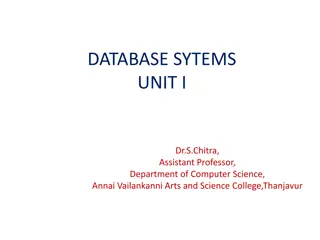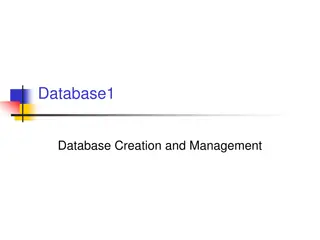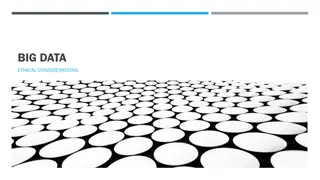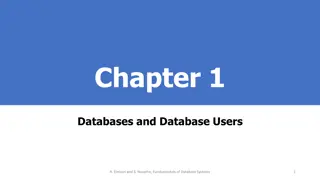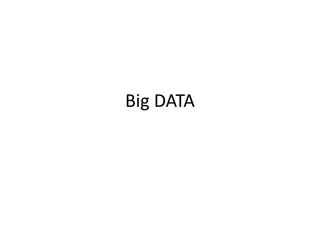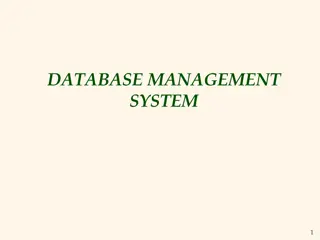Database Systems: Big Data Challenges and Solutions
This content delves into the challenges posed by big data including data volume, velocity, and management costs. It explores the concept of data rotting and proposes solutions through semi-autonomous data decay strategies. The importance of managing data relevance over time and the impact of discarding information are discussed in detail.
Download Presentation

Please find below an Image/Link to download the presentation.
The content on the website is provided AS IS for your information and personal use only. It may not be sold, licensed, or shared on other websites without obtaining consent from the author.If you encounter any issues during the download, it is possible that the publisher has removed the file from their server.
You are allowed to download the files provided on this website for personal or commercial use, subject to the condition that they are used lawfully. All files are the property of their respective owners.
The content on the website is provided AS IS for your information and personal use only. It may not be sold, licensed, or shared on other websites without obtaining consent from the author.
E N D
Presentation Transcript
EPL646: Advanced Topics in Databases A Database System with Amnesia A Database System with Amnesia. Martin Kersten, Lefteris Sidirourgos By: Frederikos Leandrou 1 https://www.cs.ucy.ac.cy/courses/EPL646
Motivation Big Data is a challenge Easy to collect and hoard massive amounts of data Volume and Velocity make processing and managing a costly affair Common scale-out approaches will soon reach a technological and monetary wall Blindly rejecting data or reducing data resolution may lead to loss of valuable data https://www.cs.ucy.ac.cy/courses/EPL646 2
Motivation Multiple DBA are needed to deal with these challenges at a cost This calls for a DBMS with a fundamental change in database management https://www.cs.ucy.ac.cy/courses/EPL646 3
Background Big Data fueled by the ease that data can be collected and stored away Costs for storing huge amounts of data become a burden Utility of data decreases over time, old data becomes stale and irrelevant Cannot afford to maintain everything in cold storage Cloud storage is cheap but retrieval is very slow Discarding data upstream may lead to loss of important data https://www.cs.ucy.ac.cy/courses/EPL646 4
Data Rotting A proposed solution to the Big Data problem Let DBMS semi-autonomously rot away data Based on the systems own unwillingness to keep old data as easily accessible as fresh data Challenges the belief that the purpose of a database system is to store data forever and not let it rot away Define strategies to forget many data items and still retain the information https://www.cs.ucy.ac.cy/courses/EPL646 5
Data Rotting Forgetting data can be harmful for it leads to loss of information However, it strongly depends on the application If only interested in aggregated summaries over scientific data, missing a few tuples may not be too bad. Error vanishes behind noise encountered by taking the observations If data is about unique standing payments, forgetting information would be a big inconvenience Ideally, knowledge about all queries and their frequency would make it possible to identify if and how long a tuple is active before it can be safely forgotten https://www.cs.ucy.ac.cy/courses/EPL646 6
Data Rotting If only interested in the average value, drop two tuples that together do not affect the average If interested in profile analysis over data, identical tuples are not necessarily needed. Just maintain simple count of occurrences Data constrained by a Data Privacy Act should be forgotten within the legally defined time frame. https://www.cs.ucy.ac.cy/courses/EPL646 7
Data Rotting What happens to forgotten data? Delete all data being forgotten Stop indexing the forgotten data. A complete scan will fetch all data, a fast index-based query evaluation will skip the forgotten data Move forgotten data to cheap slow coldstorage Keep a summary, i.e., a few aggregated values (min, max, avg) of the forgotten data. Will reduce storage but will only be able to answer specific aggregation queries without any other details. https://www.cs.ucy.ac.cy/courses/EPL646 8
Simulation Fixed schema, collection of columns Tables filled with integers in range R = 0; ; DOMAIN with predefined distribution. Database amnesia strongly influenced by data distributions and query workload. https://www.cs.ucy.ac.cy/courses/EPL646 9
Simulation Data Distributions Serial, to model auto-increment key and temporal order of tuple insertions Uniform, to model data distributions found in benchmark tables such as TPC-H Normal, to model normal data distributions around the DOMAIN range mean with standard deviation of 20% Skewed, to model a more realistic where some (random) values are dominant https://www.cs.ucy.ac.cy/courses/EPL646 10
Simulation For each table T, keep a record of active and forgotten tuples, provides a basis for comparing query results with and without amnesia Database storage requirements in number of tuples in each table, remains constant and equal to DBSIZE to simulate a tight storage budget constraint. Realistically, constrain growth instead size of the database. E.g. If database starts by using half available RAM, do not let it grow beyond the 90% mark. Achieved by simply forgetting more and more tuples as you reach the upper limit https://www.cs.ucy.ac.cy/courses/EPL646 11
Simulator The base line for the simulator experiments are simple range queries over a database table, controlled by a selectivity factor S S = 1:0 would expose all forgotten tuples as an imprecision of the result set. If a range query requests all tuples, then the answer will be incomplete exactly as much as the number of forgotten tuples. A range query with S = 0:01 is less susceptible to forgotten tuples. Smaller chance a forgotten tuple being part of the query range predicate, especially if amnesia strategies are picked correctly The second query group involves simple aggregations over subranges, e.g., the average (AVG) Aggregations are more robust against forgotten tuples. Any pair of tuples with antipodal values around the average if removed won t change the outcome. The probability of a forgotten tuple to greatly distort the average value depends on the standard deviation of the value distribution. https://www.cs.ucy.ac.cy/courses/EPL646 12
Temporal Data Amnesia Consider the order in which tuples have been added to the database. Creates a time-line over which a sliding buffer of size DBSIZE defines the active tuples . (FIFO) Keeping buffer at the head of the time line only shows results based on fresh data. Streaming database applications are good examples for this kind of amnesia, where all you can see is what s in the stream Uniformamnesia, tuples retained in the database are spread over a larger segment of the time line and tuples are removed using a randomized process. For example, after each update batch we uniformly select tuples to be removed. At any round of amnesia, a tuple has the same probability to be forgotten, but older tuples have been a candidate to be forgotten multiple times. A refinement is to consider roughly two amnesia classes: retrograde and anterograde amnesia In retrograde amnesia one can t recall old memories, thus translated to database amnesia, older tuples are more easily forgotten from the database. E.g. FIFO-amnesia In anterograde amnesia, one can not accumulate new memories easily. Implement this kind of amnesia by choosing randomly mostly recently added tuples to be forgotten This strategy prioritize historical data, and a new piece of information is only remembered if it appears too often https://www.cs.ucy.ac.cy/courses/EPL646 13
Query Based Amnesia Alternative for randomized algorithms is to take the interest of past queries into account. E.g. A tuple that appears often in a query result might be considered more important and should not be forgotten easily Extend the tables with the frequency of access for each tuple and after each batch of inserts, tuples are forgotten with probability analogous to their frequency Careful not to drop most recently added tuples, will result in an anterograde amnesia behavior Use a high water mark approach, tuples are forgotten when they are not frequently accessed but also been part of the database long enough, Rotting Opposite approach would be to forget data that has been used too frequently If a tuple has been accessed too many times, then its role should be reconsidered. No data should continue to appear in a result set, if that data has not been curated, analyzed, or consumed in any other way. https://www.cs.ucy.ac.cy/courses/EPL646 14
Spatial Based Amnesia Mimic nature more closely using a forgetting algorithm fit with a bias towards areas already infected with mold because of lack of freshness Aligns with the observation that hardware errors on magnetic disks are spatially highly correlated, usually caused by disk inactivity due to lack of interest for the data stored on those areas. Implemented by keeping a list of areas of forgotten tuples, say K and set n to a value between 1; : : : ;K + 1. If n = K + 1, then start new mold for a tuple by randomly selecting a new active starting point Otherwise, look into the database tiling and extend the n-th area of forgotten tuples in either direction https://www.cs.ucy.ac.cy/courses/EPL646 15
Data Amnesia Map Data distribution plays no role, only the relative position of each tuple in the database storage space A fifo amnesia, will only highlight the latest tuples, since all old data have been forgotten The uniform amnesia strategy produces a uniform coloring which is brighter at the end because the newer the tuples, the less opportunities they had to been forgotten The anterograde amnesia strategy, retains most of the data at point 0 (initial data of the database), and then forgets all updates, starting from the oldest ones The area amnesia strategy, which chooses at random places to start a hole and expand them, shows an affect witch resembles a uniform-fifo combination. Naturally, the oldest the data the more holes they will contain, resulting to a fifo effect, but the newer the data the more uniform will be https://www.cs.ucy.ac.cy/courses/EPL646 16
Data Amnesia Map The rot amnesia strategy, depends on how fresh are the data Freshness is measured by the frequency of appearing in a result Since all range and aggregate queries are the same in our experiments, the data distribution is the differential factor for rotting Figure 2 shows the different effect of rotting for serial, uniform, normal, and zipfian distributed datasets. Figure 2 illustrates that the data distribution in combination with the amnesia has a strong impact on what you retain from the past https://www.cs.ucy.ac.cy/courses/EPL646 17
Range query precision If the user is mostly interested in the recently inserted data then a FIFO style amnesia suffice. Precision and is influenced by both the data distribution, volatility and query load. The volatility captures the amount of data being forgotten at each intermediate stage. Figure 3 illustrates the results from range queries with a Normal and Zipfian data distribution. The range query generator selects a candidate value v from all active tuples and constructs the range Where attr >= v- 0.01 * RANGE and attr < v + 0.01 * RANGE where RANGE is in the range 0 to the maximum value seen up to the latest update batch. Precision drops quickly over time as more information is forgotten. Area rotting behaves differently. Biased to increasing an area, which means that a smaller fragment of range queries is affected https://www.cs.ucy.ac.cy/courses/EPL646 18
Conclusion The amnesia algorithms enable the DBMS to perform best within the resource bounds given Amnesia addresses the ever expanding data sizes in business and scientific application, which may become too voluminous or too expensive for interactive processing or their Cloud-based parallel processing Database amnesia forces the DBA and the users to seriously consider the cost of keeping data available forever. The price of more information retention may not outweighs the added return on investment in storage and processing power This means that a proper choice of the data amnesia policy is required, or a timely action should be taken to compress the data into meaningful summaries https://www.cs.ucy.ac.cy/courses/EPL646 19






